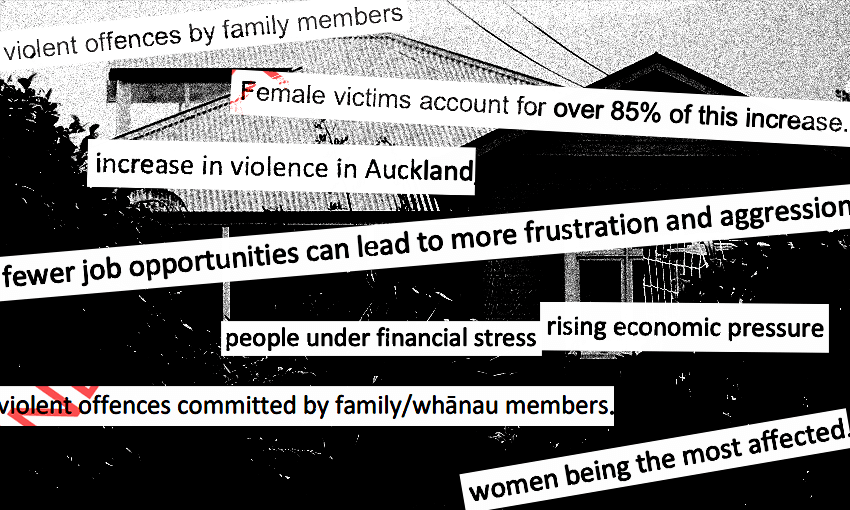The government front-footed a concerning new crime statistic, but kept the details under wraps. The full data, released under the Official Information Act, tells a far more complex story than what was presented.
Earlier this month, the government revealed that the reduced violent crime target that had been announced in April was “at risk”. Just five months into a five-year goal, new data had shown that by the metric being used for the target, violent crime had been rising rapidly.
The increase was proof, said Christopher Luxon at the press conference announcing it, “that the previous soft-on-crime approach has emboldened offenders and created a crime wave that will take a much tougher approach to stop”.
What the prime minister didn’t say was that this new data showed some clear trends, trends that may not marry up so neatly with his government’s “tougher approach”. Released to The Spinoff under the Official Information Act, the data shows an increase in family violence, older people experiencing more violent crime, and women overwhelmingly bearing the brunt of these offences. The overall increase in violent crime, meanwhile, was likely linked to “the growing economic pressure faced by many New Zealanders”.
The data – which has landed just as police begin to pull back on responding to “social harm” incidents, having earlier signalled a “managed withdrawal” from family harm callouts – is drawn from the New Zealand Crime and Victims Survey (NZCVS), widely considered to be New Zealand’s most reliable source of crime stats. It’s run by the Ministry of Justice and is what the government is using for its violent crime target, which is 20,000 fewer victims of assault, robbery and sexual assault by 2029 – a decrease from the baseline 2023 figure of 185,000 to 165,000.
Since 2018, the NZCVS has provided annual estimates of the prevalence and incidence of all crime in Aotearoa. But last week, for the first time, a quarterly release of data from the survey was made public: an estimate of the number of victims of violent crime between July 2023 and June 2024. That figure, rounded to the nearest thousand, was 215,000 – 30,000 higher than the October 2022-October 2023 figure of 185,000 (the way the survey is conducted means these two periods overlapped).
While the annual NZCVS releases give detailed breakdowns of the data by a range of variables including offence type, region and demographics, plus comprehensive supporting reports on what the findings mean, last week’s quarterly release was focused solely on violent crime and featured only the total number of victims (214,737, to be exact). Other than an emphasis that this increase might reflect crime that happened as far back as July 2022 (the survey asks respondents about their experience of crime in the past 12 months), there was no further detail about the new data.
But documents released to The Spinoff under the Official Information Act show the government received detailed notes that broke down the data and explained key trends. The documents caution that the quarterly data releases are not as reliable as the annual findings, which are weighted to accurately reflect the general population. Below are the main findings, summarised.
Women made up 85% of the increase
The vast majority, 26,000 of the 30,000 additional victims of violent crime, were women, which marked a 26% relative increase compared to the baseline 2023 figure.
Family violence rose sharply
There were 28,000 more victims of violent offences by family members, a rise of 63%. The majority of these, 83%, were women. Men saw a larger increase in violent offences committed by strangers (11,000 more victims, representing a relative increase of 21%, which accounted for 55% of the total rise).
The number of older victims doubled
The increase in family violence was particularly notable among those aged 60 and over, with 6,600 more victims than the 2023 figure – a relative increase of 250%. In terms of all violent crime, the number of victims aged 65 and over doubled from the baseline figure to 7,200, accounting for 24% of the overall increase.
Non-sexual assault and robbery saw the biggest rises
The bulk of the increase was in non-sexual assault and robbery (a 20% relative increase, from 116,000 to 140,000 victims), while sexual assault victims increased by 9% (76,000 to 83,000).
There was a big increase in violent crime in Auckland
Auckland saw 20,000 more victims of violent crime, representing a relative increase of 33%. This increase was concentrated in Waitematā (north and west Auckland), where it was predominantly due to violent offences committed by strangers. Violent crime also rose in Auckland City, which saw a relative increase of 60%, and family violence also increased most notably in Auckland.
Those under financial stress were more affected
Adults who cannot meet an unexpected expense of $500 without borrowing were disproportionately represented among victims of violent crime, representing a relative increase of 43% since 2023. This led the NZCVS team to conclude that, “The increase in victims is likely due to rising economic pressure experienced by many New Zealanders… The increasing unemployment rate observed in Stats NZ data may also contribute to economic stress, as fewer job opportunities can lead to more frustration and aggression, which in turn increases tension in households.”





